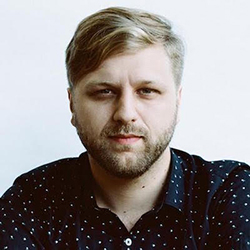
Ben Michel has a pretty epic talk scheduled for Node PDX… if you don’t know Ben he’s a Musician–Developer. He composes & performs live soundtracks and cares a lot about community music.
The talk he has planned for you all is described as, “Music as an idea, expression, commercial endeavor, and communal art is in its most volatile state since the European Renaissance. We’ve moved from the public adoption of recording technology, through the massive rise and fall of the recording industry, to a new age that was first seeded at Bell Labs during the Computer Science era.
Max Mathews encouraged a generation of computer musicians by declaring the Nyquist-Shannon “sampling theorem shows that there are really no limits to the sounds you can make…the computer is a universal musical instrument.”
Now with a fuller understanding of what Mathews was implying, we can take it a step further and say that the Browser is the universal musical instrument. It’s the most accessible, cross-compatible runtime yet–and with the growth of Web Audio and Web MIDI standardization, we’re on the verge of a new renaissance in musical collaboration and interaction.
Unfortunately, the promotion of individualism in our popular culture, and the divide between developers and working artists has kept us from realizing the potential of building useful tools for distributed music collaboration, even in the web platform.
Still, I can see a world coming where community music and recorded works are not identified by regional boundaries, but distributed data regions and organic peer to peer networks. If the development of Web Audio and it’s supporting standards stabilize, music collaboration and exposition could be made available to everyone with no hinderances from age, class, or personal ability.
The WebSound project is my iterative solution to this problem through long-term community engagement, and Audio/MIDI tool versioning.
Our first endeavor is to build a few useful live performance tools enabling remote collaboration:
- Real-time Web MIDI performances streamed to a live-event, enabling the performer to lead songs or compositions remotely. Achieved through an optimized VPN and P2P WebRTC DataChannels.
- Communally performed live music making with MIDI controlled WebAudio and WebSocket broadcasting.
- Audience interaction with the exposed parameters of a live band’s instrumentation–via broadcast methods and microcontroller installations.”







